I have been meaning to put up a post in this community since forever now and finally, one of my adventures across India has given me the opportunity to feature something about the architecture of the city in this community, Most importantly, Mughal architecture.
(She's No Longer Active Here Though) decided to spend about three days in the city in which two of the days were well spent in exploring the city and one of the day where we attended the concert.Last weekend I had the chance to visit Hyderabad only because Ed Sheeran was playing in town for the weekend and I thought why not make an entire trip out of this and Me & @yugadi @alstonsjournal @foodiechique
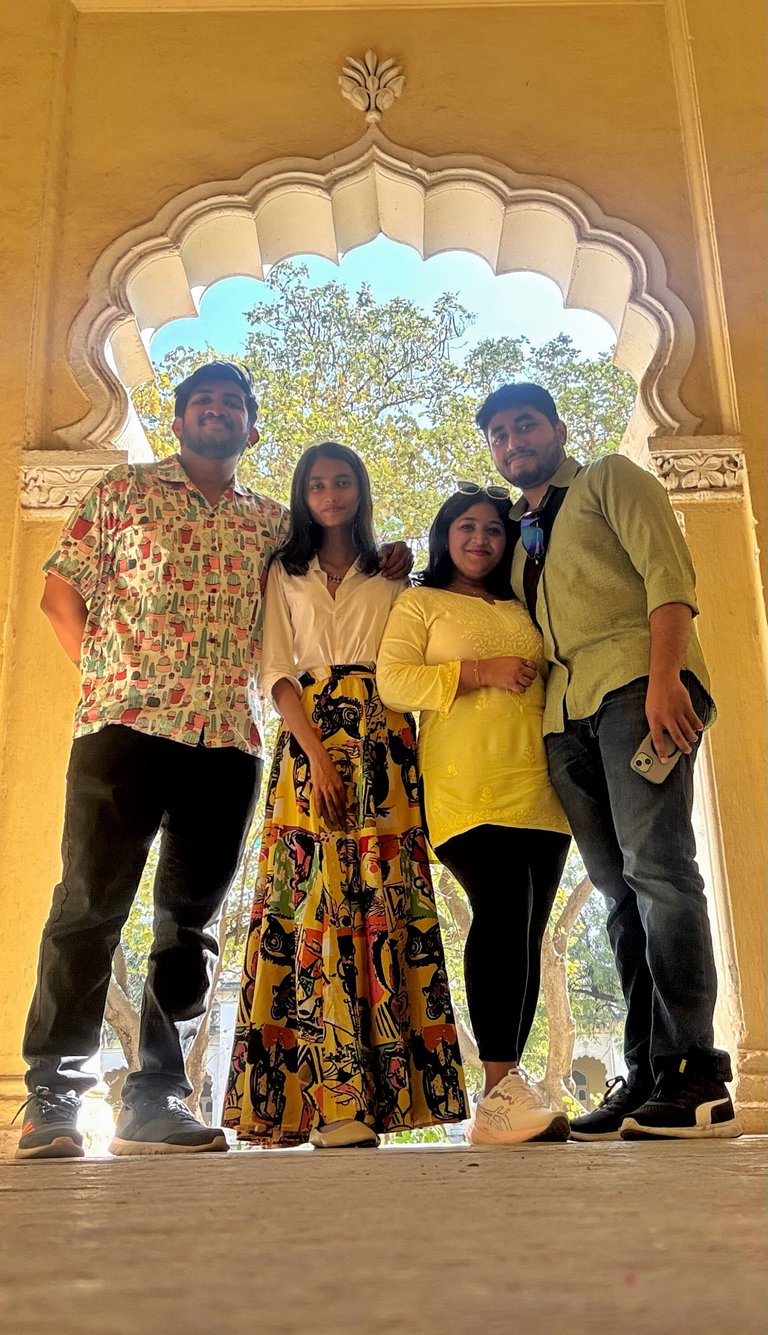
Here's The 4 of Us At Chowmahalla Palace

Chowmahalla Palace
Chowmahalla Palace
Our first stop on day one was the Chowmahalla Palace once home to the Nizams of Hyderabad now stands tall as a tribute for the visitors that come by to admire the blend of Persian, Mughal, and European architecture and royal artifacts.
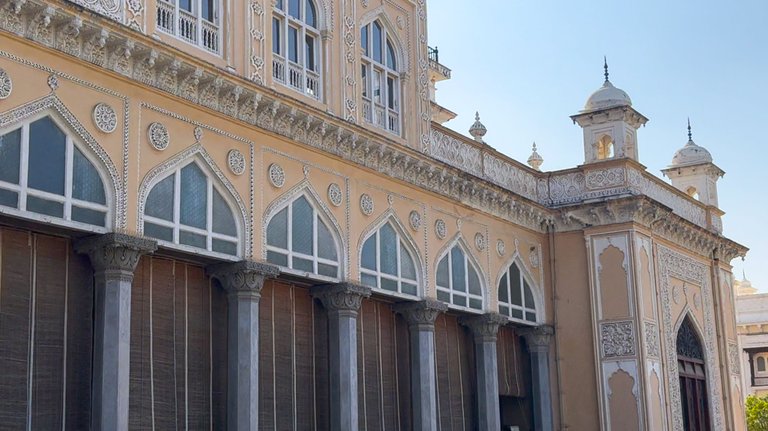
Khilwat Mubarak
Khilwat Mubarak
Chowmahalla Palace is where architectural influences from the Mughals, Qutb Shahis, Iran, and Turkey come together in a seamless, grand design. The highlight? The double height darbar hall, built in a Turko Iranian style, with Qutb Shahi inspired columns lining the verandas. Right in the center of this opulent space sits the marble throne, Takht-i-Nishan, draped in a Mughal style masnad (A Cover Of Sorting s For The Seats). This was the heart of royal power where coronations took place, grand ceremonies unfolded, and the Nizams held court with their people.
Step inside Khilwat Mubarak today, and you’ll find ‘Silsila-a-Asafia,’ an exhibition that dives deep into the lives and legacy of the Asaf Jahi Nizams. Right after, ‘Mahallat’ offers a rare glimpse into the zenana showcasing the fashion, daily life, and artistic expressions of the royal women. Then there’s the Seileh Khana, an absolute spectacle of arms. Walls lined with an impressive range of swords, shields, guns, bows, and some of the finest weapon craftsmanship from the era it’s a sight to take in.
As you head upstairs, you’ll be greeted by a treasure trove of paintings, intricate crockery, fine cutlery, and handloom wonders. This isn’t just a collection; it’s history frozen in time. Take it slow some of these artifacts are so rare, you may never see them again.
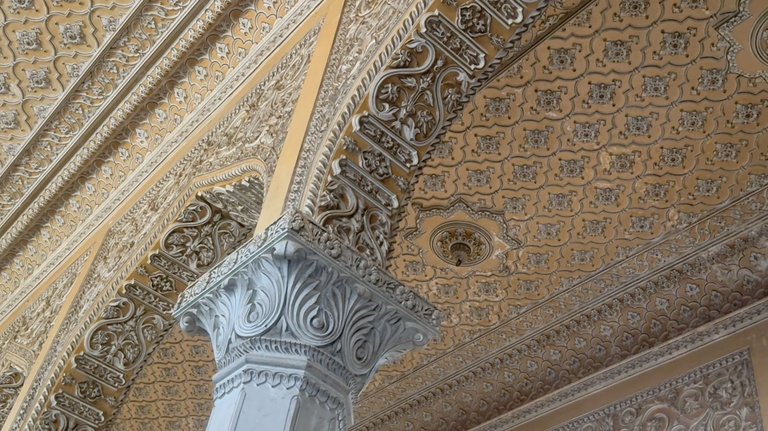
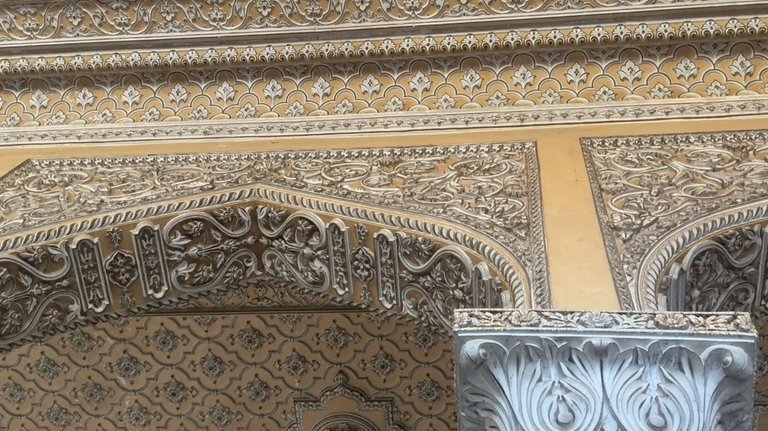
Chowmahalla Palace, true to it's name, comprises four palaces—Afzal Mahal, Tahniyat Mahal, Mahtab Mahal, and Aftab Mahal—each reflecting the opulence of Hyderabad’s Nizams. Aftab and Mahtab Mahals, the grandest of the four, exude European influences with their Corinthian columns, ornate chandeliers, and high ceilings, while Afzal and Tahniyat Mahals maintain a more traditional Indo-Persian aesthetic.
These palaces once housed the Nizam’s private quarters, filled with exquisite carpets, intricate stucco work, and priceless artifacts that still whisper tales of royal extravagance. While only Aftab and Afzal Mahals were open to the public at the time we visited, offering a glimpse into this regal past, the other two remain closed, leaving their interiors a mystery to visitors. Walking through their halls, one can almost picture the grandeur of the past—where diplomacy, culture, and luxury intertwined seamlessly.
Towards the end of the palace segment in the video, a special treat awaits an impressive collection of vintage cars once owned by the Nizams. From classic Rolls-Royces to elegant Buicks and Cadillacs, these automobiles stand as a testament to the royal family's extravagant lifestyle and love for fine engineering. Each car, immaculately preserved, tells it's own story of a bygone era when these majestic machines rolled through Hyderabad’s streets, carrying the Nizams in unparalleled style.

Charminar
Charminar
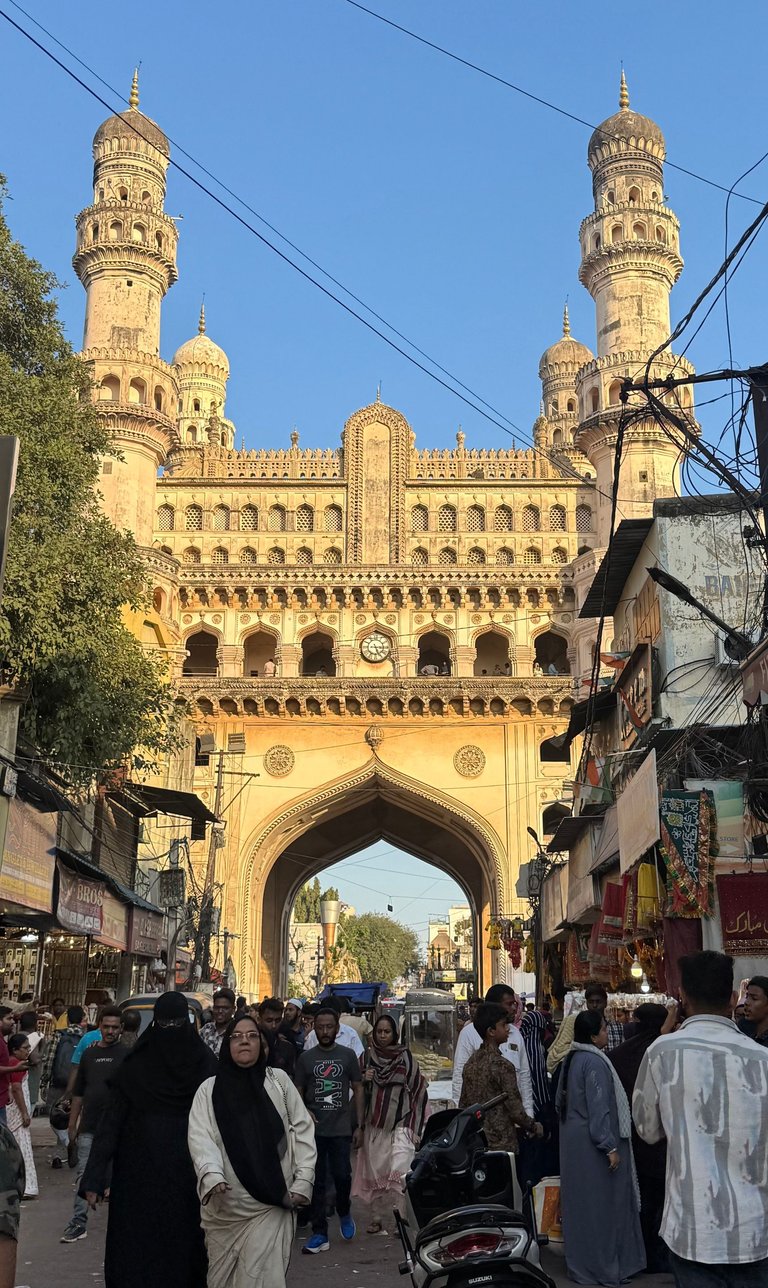
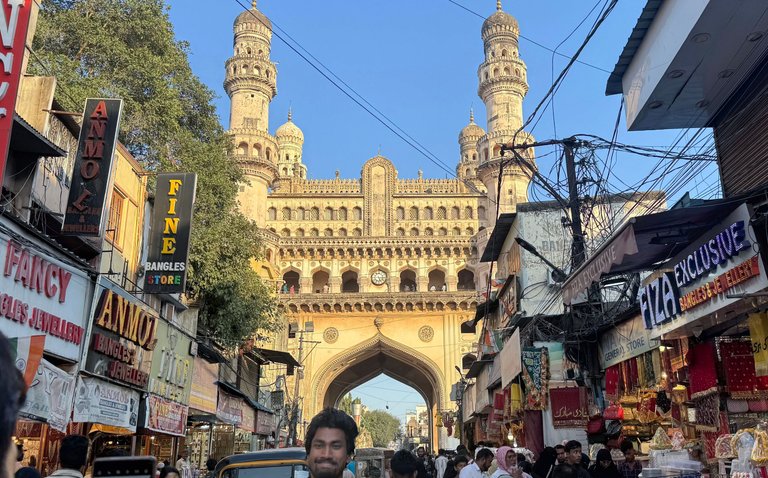
Standing tall at the heart of Hyderabad, Charminar is a masterpiece of Indo Islamic design with unmistakable Persian influences. Designed by Iranian architect Mir Momin Astrawadi in 1591, this imposing square monument stretches 20 meters on each side, with four grand minarets soaring to about 50 meters. Built with granite and lime mortar, it's structure is both solid and intricate, each of the four stories is separated by delicately carved rings, while the arches and motifs reflect the signature Qutb Shahi aesthetic.
The minarets, often believed to symbolise the four caliphs of Islam, feature a distinct lotus leaf base, an architectural hallmark of the dynasty. Tucked into the western end of the monument’s roof is a mosque, Hyderabad’s oldest accessible via 149 winding steps. Inside, 45 prayer spaces (musallah) and an open area allow for larger congregations, particularly during Friday prayers.
At the center of the courtyard, a small ablution fountain (vazu) serves as a reminder of the site’s spiritual significance. Over time, Charminar has seen modifications, including the addition of four clocks in 1889, yet it's essence remains unchanged—a fusion of elegance and resilience that has withstood the test of centuries. Whether viewed from below or atop it's minarets, the monument continues to define Hyderabad’s skyline with it's grandeur.

Bansilalpet Stepwell
Bansilalpet Stepwell
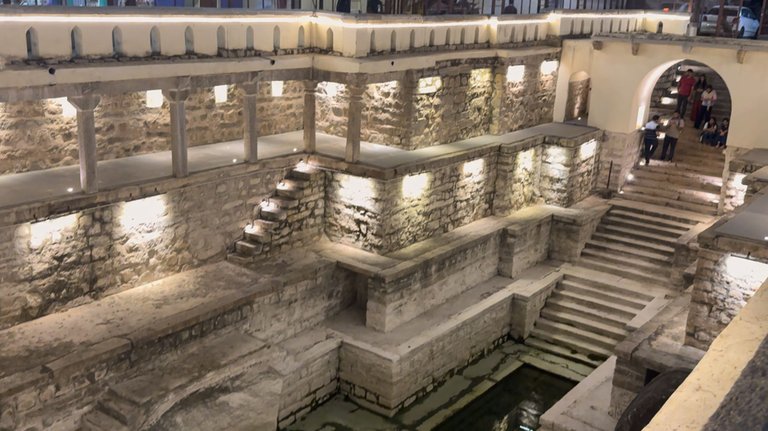
Hidden beneath years of neglect, the Bansilalpet Stepwell is a remarkable relic of Hyderabad’s past, believed to date back to the 16th or 17th century. This six layered structure, crafted from stone masonry and lime plaster, showcases a fusion of architectural influences bearing the resilience of the Kakatiyas, the refinement of the Nizams, and the imprint of British planning. Originally known as Naganah Kunta, the stepwell became part of a model village developed by British resident Terence Humphrey Keyes, funded by Seth Bansilal, whose name it now carries.
For centuries, it served as a vital water source until the 1980s, when neglect turned it into a landfill, burying its heritage under layers of debris. The recent restoration uncovered it's intricate design ornamented steps, symmetrical tiers, and a testament to traditional water conservation techniques. Now revived, the stepwell not only reclaims its architectural grandeur but also stands as a symbol of Hyderabad’s enduring heritage.
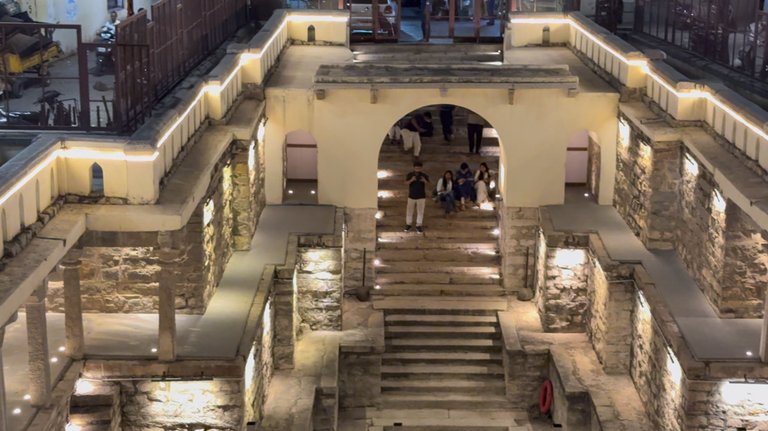
The restoration of the Stepwell was nothing short of an architectural resurrection, led by Kalpana Ramesh and her team at The Rainwater Project. What began as an overwhelming excavation of decades worth of waste soon became a painstaking process of uncovering history, layer by layer with no existing blueprints or records, the team relied on on site discoveries to guide their work, collaborating with government bodies, conservation experts, and hesitant locals who initially opposed the project.
Structural reinforcements were carefully introduced to stabilize the crumbling masonry, while skilled artisans revived the intricate lime plasterwork. The surrounding area was transformed with walkways, seating spaces, and greenery, restoring not just the stepwell but its role as a communal gathering space. Today, what was once a forgotten pit of debris stands as a testament to Hyderabad’s resilience, an architectural marvel brought back to life through sheer determination and a vision to reclaim the city's water heritage.

Qutub Shahi Tombs
Qutub Shahi Tombs
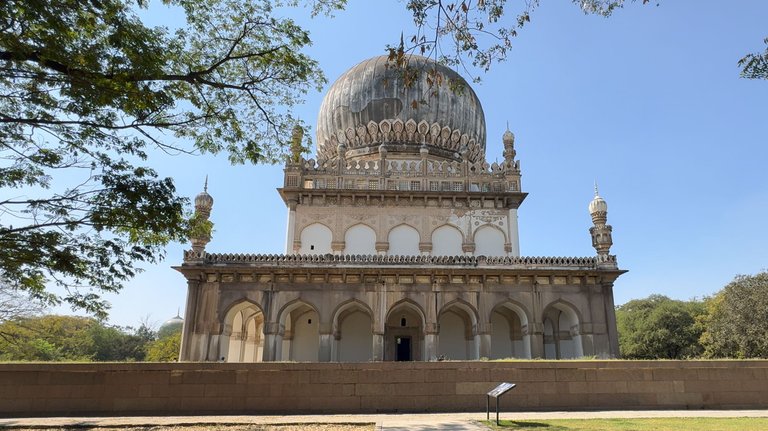
The Qutub Shahi Tombs is an enduring testament to the grandeur of the Golconda rulers, housing the final resting places of seven generations of the Qutub Shahi dynasty. Located near the Banjara Darwaza of Golconda Fort, these tombs showcase a striking fusion of Persian, Pathan, and Hindu architectural influences, constructed from grey granite with intricate stucco ornamentation. Each tomb, set upon a raised platform, follows a quadrangular design with pointed arches and towering domes, some originally adorned with vibrant blue and green tiles, though only remnants remain today.
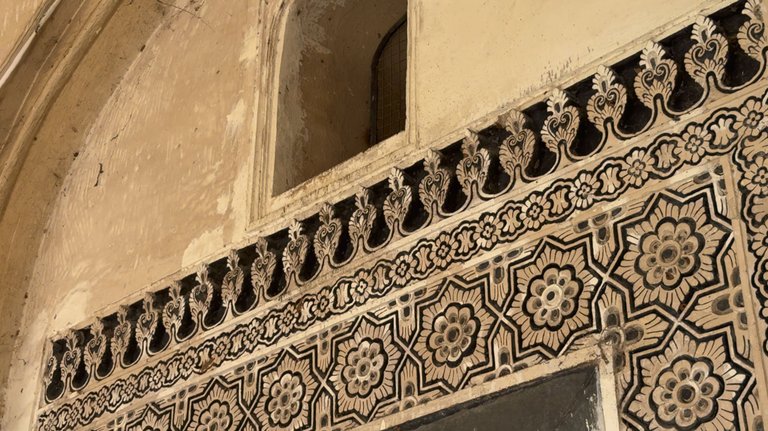
The larger tombs are two storied, reaching heights of up to 43 meters, surrounded by elegant minarets. During the Qutub Shahi period, these tombs were not only revered as sacred mausoleums but also held social significance, granting refuge even to those seeking pardon.
Among the remarkable structures within the complex is the stepwell, an essential yet often overlooked element of the site. Designed to provide water to the tombs and their surrounding gardens, the stepwell exemplifies the engineering prowess of the era. Constructed using finely hewn granite and lime mortar, it follows a symmetrical design with precisely carved steps leading down to the water source.
The well’s architecture reflects the Persian influence seen throughout the tombs, emphasizing functionality while maintaining aesthetic appeal. Despite falling into neglect after the decline of the Qutub Shahi reign, restoration efforts beginning with Salar Jung III in the 19th century and continuing under present day heritage conservation initiatives have helped revive the stepwell and it's surroundings, ensuring that this historic water system remains a part of Hyderabad’s rich architectural legacy.

Researching these four magnificent places wasn’t easy, but it was absolutely worth every moment. Over the course of three days, I sifted through countless sources, cross-referencing details to ensure accuracy, diving deep into architectural insights and restoration efforts. Then came the editing 7 straight hours of work, adjusting clips, refining transitions. This was my first major work after transitioning from Premiere Pro to DaVinci Resolve 19, and while the learning curve was steep, it was an exciting shift.

Timeline & Sources
00:00 - 03:33 Chowmahalla Palace
03:39 - 04:38 Charminar
04:43 - 05:19 Bansilalpet Stepwell
05:23 - 07:25 Qutub Shahi Tombs
07:27 - 07:46 Journey Back Home
Audio By: Farya Faraji

One important thing to note for anyone planning to document historic locations in India is that DSLR cameras are heavily restricted in most sites, and in places where they are allowed, the charges for using them can be exorbitant (P.S The Entry Fee For Foreigners Are Also Unreasonably High 😭) While I had envisioned capturing the intricate carvings, domes, and architectural grandeur in the highest quality possible, I had to adapt and rely solely on my phone camera (iPhone 15 Pro) for most of the footage.
It was frustrating at times, knowing that I could have framed certain shots better or captured finer details with my DSLR, but I made the best of what I had. Despite these limitations, I poured everything into ensuring that the essence and beauty of these places came through in my video. Hopefully, I’ve done justice to them, and if nothing else, I hope this inspires more people to explore and appreciate the rich heritage we have around us.
Hope ya'll enjoyed this article about Hyderabad's Mughal Architecture!
Upvote, Comment, Repost And Follow If You Like My Work!
Have A Great Day!
▶️ 3Speak
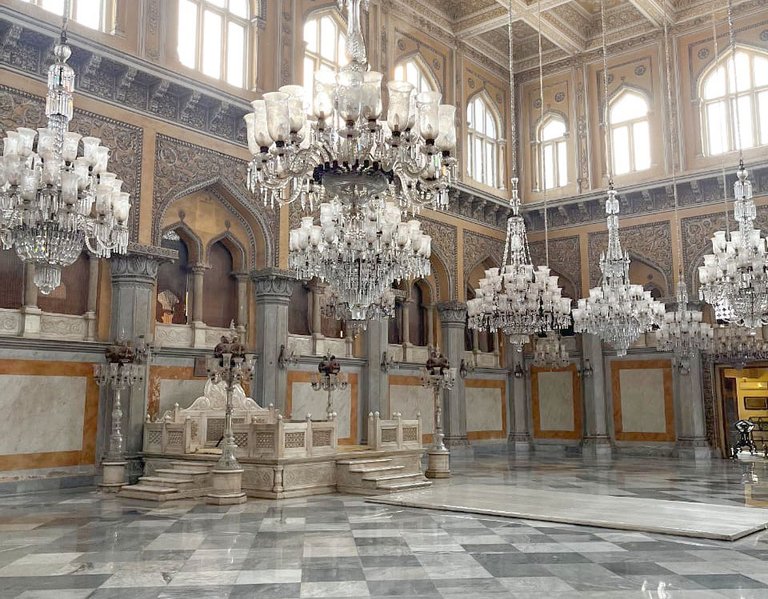


The rewards earned on this comment will go directly to the people( @bighungrypanda ) sharing the post on Reddit as long as they are registered with @poshtoken. Sign up at https://hiveposh.com. Otherwise, rewards go to the author of the blog post.
Curated Content Catalog and was awarded RUNNER UP in Architecture Anthology™ 91. More power!Congratulations dear @bighungrypanda! We are delighted to inform you that your outstanding publication was specially selected as an exclusive feature for our
Thank you for subscribing to Architecture+Design, an OCD incubated community on the Hive Blockchain.
Yayy 🥹✨
Enjoy dear @bighungrypanda. Thank you for your valuable A+D contributions! 😀
Exploring these gems was so much fun! Every site was absolutely stunning.
Love how you've worked on the post ❤️
Yeah it was super fun, lets visit the Golconda Fort & Salar Jung Museum next time, if only we had more time that day ugh and thanksss ❤️✨
You can check out this post and your own profile on the map. Be part of the Worldmappin Community and join our Discord Channel to get in touch with other travelers, ask questions or just be updated on our latest features.
Epic tour! Great video dude!
Thanks bruh! 🙌🏼
A+D Personal Stories by sourcing inspirations from the following topics:Greetings dear @bighungrypanda. Thank you for your great interest in the world of architecture and design. Have fun and feel free to share more of your
https://peakd.com/hive-178708/@aplusd/architecturedesign-or-community-content-criteria
It's our tremendous pleasure to warmly welcome you to the Architecture+Design Community on Hive! 😀
Thank you for the warm welcome ✨ hoping to share more in this community this year 🙌🏼
Travel Digest #2468.
Become part of our travel community:
- Join our Discord
Hiya, @glecerioberto here, just swinging by to let you know that this post made it into our Honorable Mentions in Your post has been manually curated by the @worldmappin team. If you like what we're doing, please drop by to check out all the rest of today's great posts and consider supporting other authors like yourself and us so we can keep the project going!@bighungrypanda, one of your Hive friends wishes you a Happy Valentine's day and asked us to give you a new badge!
To find out who wanted you to receive this special gift, click here!
You can view your badges on your board and compare yourself to others in the Ranking
Check out our last posts: